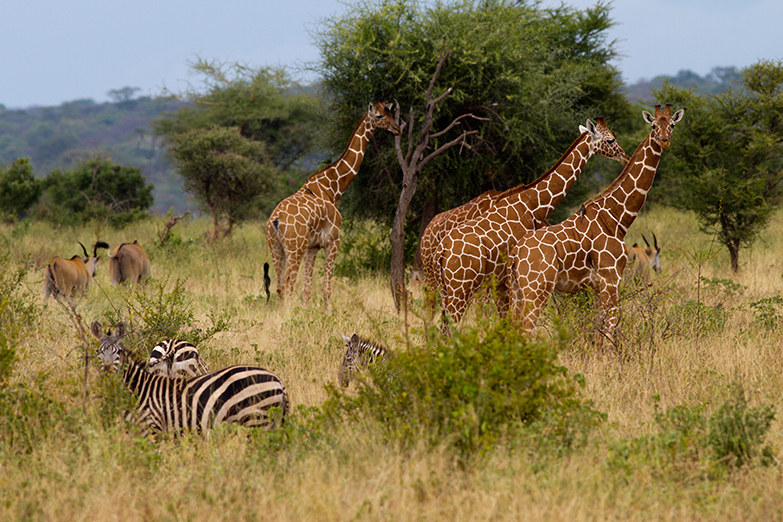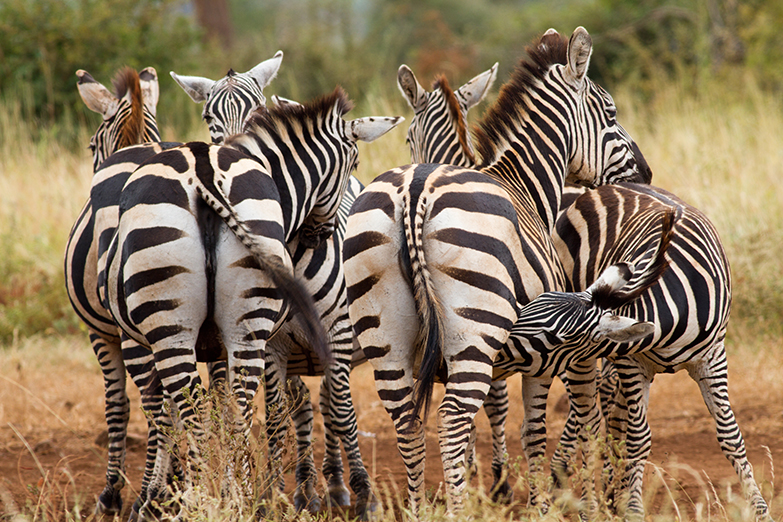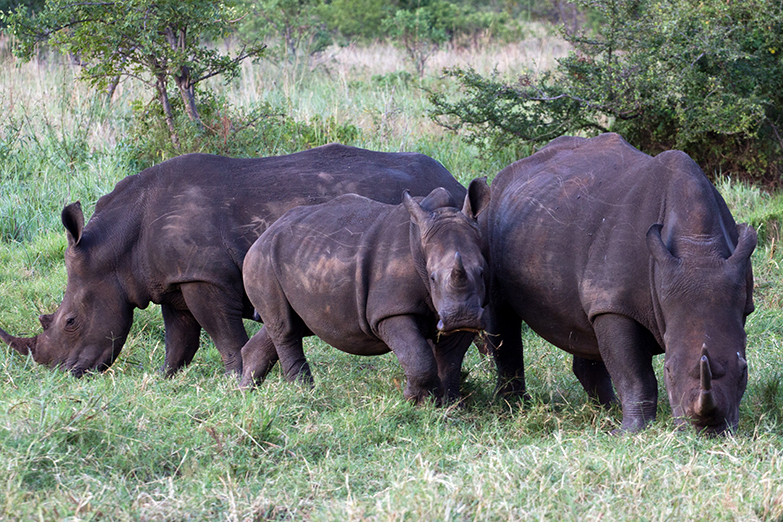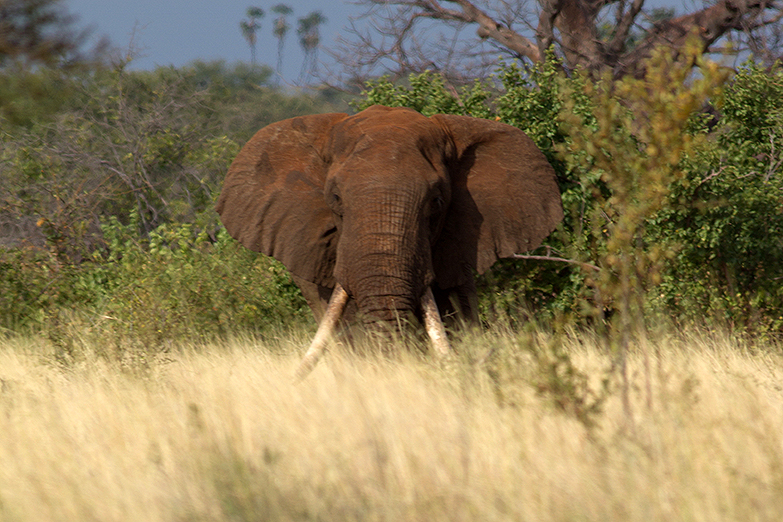Meru National Park, which sits on the slopes of Mount Kenya, would have been a popular safari destination even without Elsa and her human ‘friends’, George and Joy Adamson. In the 1970s its sweeping grassland and tangled forests teemed with large mammals and it was rightly regarded as one of Kenya’s most celebrated parks. But it was Born Free, the bestselling book and subsequent film recounting the Adamsons' life in Meru with Elsa, their semi-tame lioness, that really put the park on the map.

Giraffes, zebras and antelope at Meru National Park. Photo by Stuart Butler.
At the peak of Meru’s popularity around 40,000 people a year flocked here to gawp at elephants, rhinos, lions and other Kenyan megafauna. But then, in the late 1970s and throughout the 1980s, Meru vanished from safari tour operators' programmes thanks to a huge surge in poaching and general lawlessness. The park's infrastructure virtually collapsed and large mammals were almost completely wiped out. In 1979, 80% of the park's once famous rhinos were slaughtered and between 1984 and 1989 ivory poachers reduced the elephant population from 3,500 to just 210. Things reached a nadir at the end of the ‘80s when bandits killed a couple of French tourists and then murdered George Adamson, the man who’d done so much to promote the park, in neighbouring Kora National Reserve.

A herd of zebras at Meru National Park. Photo by Stuart Butler.
Lying back in an outdoor bath tub hewn out of the surrounding rock, I gazed out across what felt like half of northern Kenya and considered Meru’s riches-to-rags-and-back-to-riches story. It had taken determination, significant investment, the beefing up of security and the translocation and re-introduction of large mammals to get Meru back in business. But back it was, and I was staying in Elsa’s Kopje (elsaskopje.com), a luxury lodge built on, around and pretty much into the pinky-granite rock of a hill once used by the Adamsons, and Elsa the lioness, as their base in Meru. Over the last few days I’d explored the park's gold-tinted savannah grasslands and played peek-a-boo with elephants, giraffes and all the rest in dense forests, but what had made this safari truly special was that I hadn’t seen a single other tourist vehicle. If you like your safari wild and empty, then right now Meru National Park might be the most exciting park in Kenya.

Black rhinos at Meru National Park. Photo by Stuart Butler.
A lion made Meru famous, but I'd come for the rhinos. These prehistoric-looking creatures came close to being wiped out during Meru’s dark days but today, despite the current Africa-wide poaching epidemic, Meru's population is flourishing. In 2002 around half a dozen rhinos were translocated to Meru from other protected areas in Kenya. That small group has now grown to some 77 individuals, including both black and white species. Under constant armed protection, they live in a 48-sq km fenced ‘park within a park’ (soon to expand to 84 sq km). And round-the clock supervision means that rangers always know where they can be found, making Meru National Park about the best place in Kenya to see rhinos.
Meru isn’t the only place in the region to see them, though, and nor are rhinos the only big attraction of this part of Kenya.

An elephant emerging from the bush at Meru National Park. Photo by Stuart Butler.
Mt Kenya: The lofty goal of any self-respecting Kenya-bound trekker, the sky-scratching 5199m bulk of Mt Kenya, Africa’s glacier-scarred second highest peak, is just a snowman’s stride from the Equator – or perhaps that should be was a snowman’s stride from the Equator. Today the glaciers are rapidly melting and ice on the Equator will soon be a thing of the past. Climatic issues aside, scaling Mt Kenya is still one of the most memorable things you can do on an East African adventure. The mountain's ecosystems vary radically by altitude; you can expect to walk through upland forests, bamboo forests, high-altitude equatorial heathland, lower alpine moorland and, finally, the rock and ice of the summit. In the lower altitudes wildlife is common, but it’s the plant life that takes centre stage: hairy carpets of tussock grass, brushlike giant lobelias and the bizarre giant groundsel.
Aberdare National Park: Although the thick belt of rainforest that hugs the eastern side of the Aberdare National Park is clogged with animals, it’s the open tableland of coarse moors and cold mountain mornings that is the real signature of this diverse and under visited park. Wildlife is abundant and includes melanistic (black) leopards, buffalo and bongo (antelope), and more rhinos, but it is much harder to see than in the famous savannah reserves of southern Kenya. Instead, this is a park in which to escape the confines of a safari bus and lace up the hiking boots. Ol Donyo Lesatima (4000m) is the highest point and a natural goal, but the walk to the Karura Falls might be even more rewarding.
More places to see rhinos: If you can’t get enough of the horned ones, don’t miss the Solio Game Ranch (www.thesafaricollection.com), a private wildlife conservancy north of Nyeri, which is one of Kenya’s most important breeding centres for black rhinos. A self-drive safari accompanied by a guard is likely to turn up a number of the lumbering animals. The Laikipia plateau (www.laikipia.org), a bizarre mix of communal rangeland, commercial ranching and private wildlife conservancies, is another rhino hotspot; the renowned Lewa conservancy (www.lewa.org) has a fairly healthy population, although even here poachers have recently taken a heavy toll, with nine rhinos killed in 2012 alone.
For more information about all of Kenya's parks, visit the Kenya Wildlife Service website (www.kws.org).